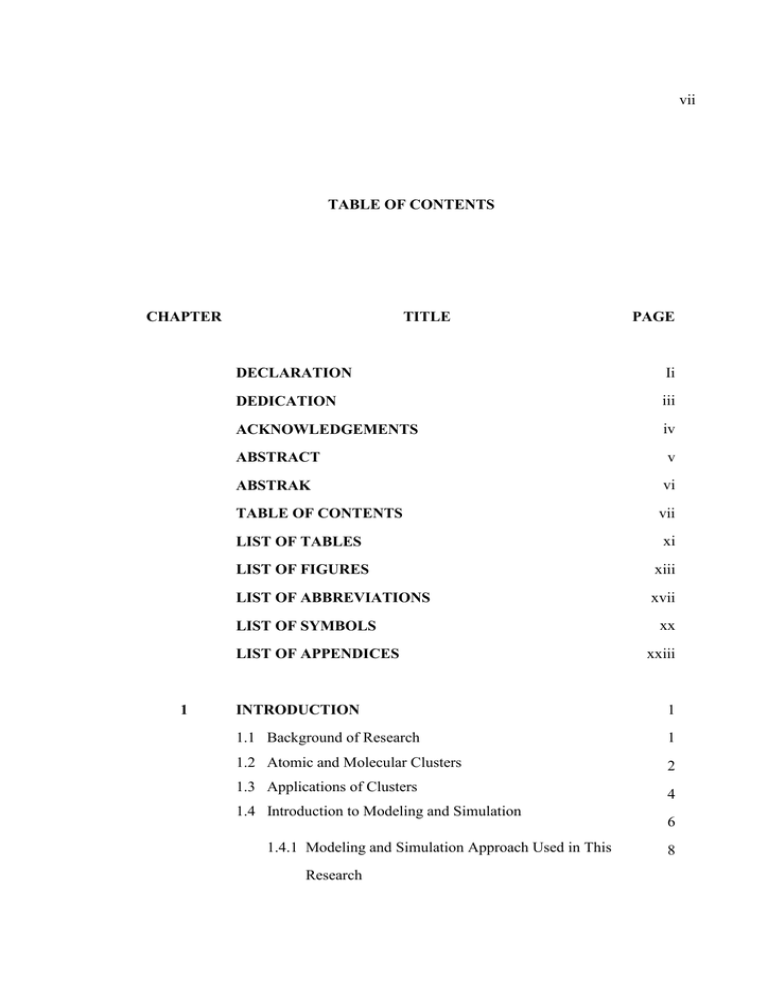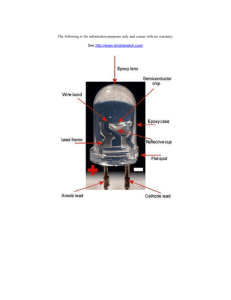TABLE OF CONTENTS CHAPTER TITLE PAGE
advertisement

vii TABLE OF CONTENTS CHAPTER TITLE DECLARATION Ii DEDICATION iii ACKNOWLEDGEMENTS iv ABSTRACT v ABSTRAK vi TABLE OF CONTENTS vii LIST OF TABLES xi LIST OF FIGURES xiii LIST OF ABBREVIATIONS xvii LIST OF SYMBOLS LIST OF APPENDICES 1 PAGE xx xxiii INTRODUCTION 1 1.1 Background of Research 1 1.2 Atomic and Molecular Clusters 2 1.3 Applications of Clusters 1.4 Introduction to Modeling and Simulation 1.4.1 Modeling and Simulation Approach Used in This Research 4 6 8 viii 2 1.5 Research Objectives 9 1.6 Scopes of Study 9 1.7 Outline of Dissertation 10 COMPUTATIONAL METHOD 11 2.1 Computational Materials Science (CMS) 11 2.2 Density Functional Theory 16 2.2.1 Development of Density Functional Theory 17 2.2.2 Kohn-Sham Theory 18 2.2.3 Self-Consistent Field (SCF) 22 2.2.4 Non-Self Consistent Field 22 2.2.5 Exchange-Correlation Functionals 23 2.2.5.1 Local Density Approximation for 23 Exchange-Correlation Energy 2.2.5.2 Generalized Gradient Approximation 26 (GGA) 2.2.6 DFT Choice of Electronic Structure 2.3 Basis Set 2.3.1 Plane Wave Basis Set 2.3.2 Projected Augmented Wave (PAW) 30 32 33 37 Pseudopotentials (PP) in Plane Wave Basis 3 METHODOLOGY 39 3.1 Introduction to VASP 39 3.1.1 Software Packages Needed by VASP 3.2 Files Used by VASP 41 43 3.2.1 INCAR File 44 3.2.2 POTCAR File 44 3.2.3 POSCAR File 45 ix 3.2.4 KPOINTS File 45 3.3 Algorithm Used in VASP 47 3.3.1 Conjugate Gradient Algorithm 51 3.3.2 Block Davidson Algorithms 52 3.3.3 Residual Minimization Scheme-Direct Inversion 53 In The Iterative Subspace (RMM-DIIS) 3.4 Simulation Process 54 3.4.1 Construction of Clusters 55 3.4.2 Geometry Optimization 56 3.4.2.1 INCAR for Conjugate Gradient 58 Geometry Optimization 3.4.2.2 INCAR for Simulate Annealing 60 3.4.2.3 KPOINTS for Geometry Optimization 65 3.4.3 Electronic Structures Calculations 65 3.4.3.1 INCAR for Self-Consistent Run 66 3.4.3.2 INCAR for Non-Selfconsistent Run 67 3.4.3.3 KPOINTS for Non-Selfconsistent and 68 Bandstructure 4 SIMULATION RESULT AND ANALYSIS 69 4.1 Simulation of Bulk Gallium Arsenide and Gallium Arsenide Dimer 69 4.2 The Effect of Size on the Electronic Structures of 73 Gallium Arsenide Clusters 4.2 The Effect of Shape on the Electronic Structures of Gallium Arsenide Clusters 80 4.3.1 Optimized Geometry Structure 4.3.2 Electronic Structures 4.4 Effect of Hydrogen and Reconstructed Surface to Electronic Structures 82 87 102 x 5 SUMMARY AND CONCLUSION 105 5.1 Summary and Conclusion 105 5.2 Suggestions 108 5.2.1 Improvement of the Bandgap Accuracy 108 5.2.2 Improvement of the Computation Time 109 REFERENCES 113 APPENDICES 121 xi LIST OF TABLES TABLE NO 1.1 2.1 TITLE Schematic classification of clusters according to the number N of atoms. Comparison of accuracy of various computational tools. PAGE 3 31 3.1 A relatively large number of input and output files of VASP. 43 3.2 Coordinates of high symmetry k-points in Cartesian and reciprocal mode. 46 4.1 Bandgap energy for each of the cluster. 77 4.2 The configurations and point group for each of the gallium arsenide clusters, GaxAsy. 82 4.3 Energy level (HOMO and LUMO) as well as bandgap value of each GaxAsy clusters, (x +y ≤ 15 ). 95 4.4 Binding energy per atom of each gallium arsenide cluster, GaxAsy (x + y ≤ 15 ). The binding energies are not corrected with zero potential energies. 96 4.5 Second-difference enegies and electron affinity of each gallium arsenide cluster, GaxAsy (x + y ≤ 15 ). 97 xii 4.6 Bandgap (eV) comparison of bare non-optimized tetrahedral gallium arsenide clusters, hydrogenated gallium arsenide clusters and surface reconstructed gallium arsenide clusters. 102 5.1 Execution time, speedup and efficiency of VASP using parallel computing. 111 xiii LIST OF FIGURES FIGURE NO TITLE PAGE 1.1 Computational science is defined as the intersection of the three disciplines, i.e. computer science, mathematics and applied science. 2.1 Schematic depicting self-consistent loop. 21 2.2 Schematic diagram depicting the energy density for inhomogeneous electron gas system (left hand panel) at any location can be assigned a value from the known density variation of the exchange-correlation energy density of the homogeneous electron gas (right hand panel). 26 2.3 Schematic illustrating the a supercell model for a isolated molecule. The dashed line depicts the boundaries of the supercell. 35 2.4 Schematic representation of a pseudopotential (left) and a pseudowavefunction (right) along with all-electron potential and wavefunction. The radius at which allelectron and pseudofunction values match and identical is rc. The pseudofunctions are smooth inside the core region. 36 2.5 Schematic depicting principle of pseudopotential, of which core electrons are neglected. 36 8 xiv 2.6 Schematic depicting the decomposition of exact wavefunction (and energy) into three terms 38 3.1 The First Brillouin zone of a fcc lattice, with high symmetry k-points and direction of planes marked. 46 3.3 Flow chart of the electronic structure simulation process of gallium arsenide clusters. 55 3.4 (a) Bulk gallium arsenide with its unit cells repeated in 3 dimensions. (b) supercells with Ga2As2 cluster in the center and the distance between clusters is large. The brown’s colour show the Ga atoms and purple’s colour show the As atoms. 56 3.5 Algorithm of geometry optimization used for large clusters. 58 3.6 Parameters for CG algorithm in INCAR file. 59 3.7 Conjugate gradient techniques: (top) Steepest descent step from x0 search for minimum along g 0 by performing several trial steps to x1 . (below) New gradient g 0 g x1 is determined and s1 (green arrow) is conjugated. 60 3.8 Parameters for SA algorithm in INCAR file. 61 3.9 Flowchart illustrating the algorithm of SA. 64 3.10 Parameters for geometry optimization in KPOINTS file. 65 3.11 Parameters for self-consistent run in INCAR file. 66 3.12 Parameters for non-selfconsistent run in INCAR file. 67 3.13 Parameters for non-selfconsistent run in KPOINTS file. 68 4.1 (Left) Structure of zinc blende bulk gallium arsenide; (Right) Structure of Ga1As1.dimer. 70 4.2 Bandstructure of bulk gallium arsenide. 71 4.3 DOS of bulk gallium arsenide 72 xv 4.4 4.5 Ball and stick model for hydrogenated gallium arsenide clusters. Bandstructrue and DOS of hydrogenated gallium arsenide clusters, GaxAsyHz. 74 76 4.6 Band shift related to the cluster size. The upper line is HOMO energy value while lower line is LUMO energy value. 77 4.7 Lowest energy geometries for the GaxAsy (x + y ≤ 15). 81 4.8 DOS and bandstructure of Ga1As1 cluster. 88 4.9 DOS and bandstructure of Ga1As2 cluster 88 4.10 DOS and bandstructure of Ga2As2 cluster 89 4.11 DOS and bandstructure of Ga2As3 cluster 89 4.12 DOS and bandstructure of Ga3As3 cluster 90 4.14 DOS and bandstructure of Ga4As4 cluster 91 4.15 DOS and bandstructure of Ga4As5 cluster 91 4.16 DOS and bandstructure of Ga5As5 cluster 92 4.17 DOS and bandstructure of Ga5As6 cluster 92 4.18 DOS and bandstructure of Ga6As6 cluster 93 4.19 DOS and bandstructure of Ga7As6 cluster 93 4.20 DOS and bandstructure of Ga7As7 cluster 94 4.21 DOS and bandstructure of Ga7As8 cluster 94 4.22 Graph of bandgap versus number of gallium arsenide atom in the cluster. 95 4.23 Graph of binding energy per atom of gallium arsenide clusters. 96 xvi 4.24 Graph of second-difference energies and electron affinity of each gallium arsenide cluster, GaxAsy (x + y ≤ 15 ) corresponding to the table above. 5.1 Graph of total time used for completing a parallel calculation versus the number of CPU. 111 5.2 Graph of speedup and efficiency vs number of CPU. 112 97 xvii LIST OF ABBREVIATIONS ATLAS - Automatically Tuned Linear Algebra Software BLAS - Basic Linear Algebra Subprograms BO - Born Oppenheimer BP - Becke-Perdew BSSE - Basis set superposition error CC - Coupled cluster theory CG - Conjugate gradient CI - Configuration Interaction CMS - Computational materials science DFT - Density functional theory DOS - Density of states ETB - Empirical tight binding EPM - Empirical pseudopotential method EMA - Effective mass approximation FFT - Fast-fourier transform GEA - Gradient expansion approximation GGA - Generalized gradient approximation GTO - Gaussian-type orbital GVB - Generalized valence bond HF - Hartree Fock theorem xviii HK - Hohenberg-Kohn HOMO - Highest Occupied Molecular Orbital HPC - High-performance cluster IFC - Intel Fortran Compiler Intel® MKL - Intel Math Kernel Library KS - Kohn-Sham theorem LCAO - Linear combination of atomic orbitals LDA - Local density approximation LAPACK - Linear Algebra PACKage LM - Langreth-Mehl LSDA - Local spin density approximation LUMO - Lowest Unoccupied Molecular Orbital LYP - Lee-Yang-Parr MCSCF - Multi-Configurations Self Consistent Field MD - Molecular dynamics MGGA - Meta-Generalized Gradient Approximation MPI - Message Passing Interface NC-PP - Norm-conserving pseudopotential NFS - Network file system PAW - Projected Augmented Wave PBE - Perdew-Burke-Ernzernhof PES - Potential energy surfaces PP - Pseudopotential PW - Plane Wave PW91 - Perdew-Wang 1991 RMM - Residual minimization scheme rPBE - Revised-Perdew-Burke-Ernzernhof RPA - Random phase approximation SA - Simulated annealing SCF - Self-consistent functional xix SSH - Secure Shell SET - Single-electron transistor STO - Slater-type orbitals US-PP - Ultrasoft Vanderbilt pseudopotential VASP - Vienna Ab-Initio Software Package VWN - Vosko-Wilk-Nusair QMC - Quantum Monte Carlo WF - Wavefunction xx LIST OF SYMBOLS E - Energy EF - Fermi Energy Eg - Energy gap / bandgap EXC - Exchange-correlation energy f(E) - Fermi energy F - Force g(E) - Density of states g - Spin-scaling factor G - Reciprocal lattice vector - Planck’s constant h - Dirac constant H - Hamiltonian J n - Coulomb interaction k - Wavenumber kB - Boltzmann’s constant L - Edge length L̂ - Angular momentum operator m - Mass n - Quantum number of state (integer) N - Number of electron nr - Electron density xxi p - Momentum p̂ r - Linear momentum operator ~ plm r, r - Projector function - Position vector ri - Electron spatial coordinates rs - Wigner-Seitz radius Rnl r - Radial wavefunction R - Radius RA - Nuclei spatial coordinates s, t - Dimensionless density gradient t - time To - Kinetic energy T - Temperature uk - Bloch function U - Potential Energy V - Volume Yl m , - Spherical harmonic ZA - Nuclei charge λ - Wavelength 2 ∆ - Second-order difference energy Ψ - Wavefunction υ - Velocity ω - Angular frequency ν - Frequency r - Envelope function Θ - Unit step function ε - Energy εi - Single-particle energy level μ - Chemical potential - Laplacian operator xxii - Spin-polarization r - Kinetic energy density Ω - Volume of unit cell η - Voltage division factor ρ - Density matrix Ga - Gallium As - Arsenide GaxAsy - Gallium arsenide cluster with x,y atom GaxAsyHz SN - Hydrogenated gallium arsenide cluster with x,y atom and z hydrogen atom Speedup EN - Efficiency xxiii LIST OF APPENDICES APPENDIX A TITLE Parallelization of VASP PAGE 113


